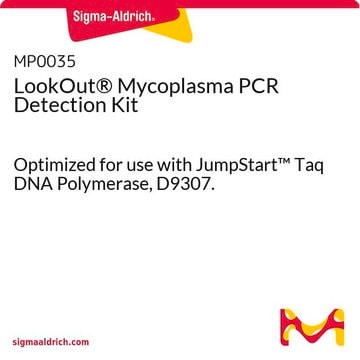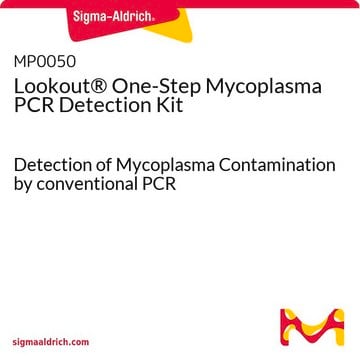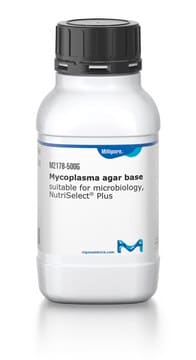Recommended Products
usage
sufficient for 96 reactions
manufacturer/tradename
Roche
shipped in
dry ice
storage temp.
−20°C
Specificity
Application
Mycoplasma PCR ELISA kit has been used for the detection of contamination by mycoplasma/acholeplasma/ureaplasma in cell cultures or other sample materials.
Features and Benefits
Sample material: Cell culture supernatants, cell suspensions, or other samples
Sensitivity: At least 1 x 103 colony-forming units (cfu) of mycoplasma per milliliter of culture medium
- High sensitivity: Detects 1 - 10fg of DNA, corresponding to approximately 1 - 20 gene copies per reaction (at least 103cfu/ml)
- Broad detection range: All mycoplasma, acholeplasma, and ureaplasma species tested thus far were detected
- Simplicity: Detects all mycoplasma using the same protocol, as opposed to the culture method that requires different culture conditions for different mycoplasma species
- Fast results: The entire procedure can be performed in one day
- Easy handling of large numbers of samples: The ready-to-use mix and ELISA detection procedure allow fast and semi-automatic sample processing
Packaging
Sequence
Other Notes
Kit Components Only
- Lysis Reagent
- Neutralization Reagent
- PCR Mix ready-to-use
- Denaturation Reagent
- Hybridization Buffer
- Biotinylated Capture Probe
- Washing Buffer 10x concentrated
- Anti-Digoxigenin-POD antibody
- Conjugate Dilution Buffer
- TMB Substrate Solution
- Stop Reagent
- Positive Control DNA
- Streptavidin-coated Microplate
- Adhesive Plate Cover Foils
Signal Word
Warning
Hazard Statements
Precautionary Statements
Hazard Classifications
Eye Irrit. 2 - Skin Irrit. 2 - Skin Sens. 1
Storage Class Code
12 - Non Combustible Liquids
WGK
WGK 2
Flash Point(F)
does not flash
Flash Point(C)
does not flash
Certificates of Analysis (COA)
Search for Certificates of Analysis (COA) by entering the products Lot/Batch Number. Lot and Batch Numbers can be found on a product’s label following the words ‘Lot’ or ‘Batch’.
Already Own This Product?
Find documentation for the products that you have recently purchased in the Document Library.
Customers Also Viewed
Articles
Mycoplasmas are potential contaminants in mammalian cell culture manufacturing. All products produced in cell culture to be tested for the presence of Mycoplasma
Protocols
Mycoplasma contamination of cell cultures is a serious issue impacting cell model validity. PCR testing for mycoplasma is an inexpensive, sensitive, and specific method for detecting contamination.
Our team of scientists has experience in all areas of research including Life Science, Material Science, Chemical Synthesis, Chromatography, Analytical and many others.
Contact Technical Service











